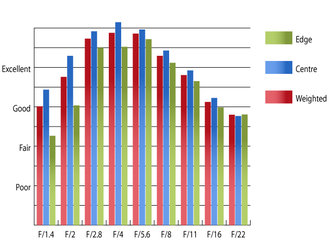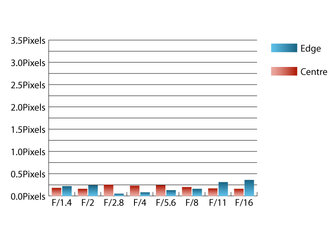Fujifilm XF Fujinon 23mm f/1.4 R Lens Review
Fujifilm XF Fujinon 23mm f/1.4 R Performance
At maximum aperture, sharpness in the centre of the frame is very good, although the clarity towards the edges of the frame falls behind by quite a margin. Stopping down improves performance across the frame, with sharpness towards the edges of the frame reaching good levels by f/2 and peak performance being achieved between f/2.8 and f/5.6, here sharpness is outstanding across the frame.  MTF @ 23mm | How to read our chartsThe blue column represents readings from the centre of the picture frame at the various apertures and the green is from the edges. Averaging them out gives the red weighted column.The scale on the left side is an indication of actual image resolution. The taller the column, the better the lens performance. Simple. For this review, the lens was tested on a Fujifilm X-E1 using Imatest. |
Chromatic aberrations are extremely well controlled, with any fringing being kept to an absolute minimum across the frame. Imatest was only able to detect over a quarter of a pixel width of CA towards the edges of the frame at apertures of f11 and slower.
 CA @ 23mm | How to read our chartsChromatic aberration is the lens' inability to focus on the sensor or film all colours of visible light at the same point. Severe chromatic aberration gives a noticeable fringing or a halo effect around sharp edges within the picture. It can be cured in software.Apochromatic lenses have special lens elements (aspheric, extra-low dispersion etc) to minimize the problem, hence they usually cost more. For this review, the lens was tested on a Fujifilm X-E1 using Imatest. |
Falloff of illumination towards the edges of the frame is typical for a wide aperture lens, with the corners being 2.25 stops darker than the image centre at f/1.4. Visually uniform illumination is achieved with the lens stopped down to f/4 or beyond.
Barrel distortion is reasonable for a wide angle prime lens sporting a fast maximum aperture. Imatest detects a level of 1.15% barrel distortion. The distortion pattern is uniform across the frame, so this should be relatively simple to correct in image editing software if absolutely straight lines are required.
A petal shaped hood is supplied with the lens, which does a reasonable job of shading the lens from extraneous light that cause issues with flare. Even without the hood. this lens is resistant to flare, even in harsh back-lit situations. Contrast levels remain good when shooting into the light also.
Add your message
Login required
Please login here or if you've not registered, you can register here. Registering is safe, quick and free.
Please login here or if you've not registered, you can register here. Registering is safe, quick and free.
photodo Stats
1102 lenses
428 MTF tests
74 in-depth photodo reviews
100+ users join each day
Help the lens community by reviewing or rating a lens today via our lens search
428 MTF tests
74 in-depth photodo reviews
100+ users join each day
Help the lens community by reviewing or rating a lens today via our lens search
Latest Lens Reviews
- Chinon 28mm f/2.8 Vintage Lens Review
- Canon EF 70-200mm f/4L IS II USM Lens Review
- Samyang AF 85mm f/1.4 EF Review
- Sigma 70mm f/2.8 DG Macro Art Review
- Samyang AF 24mm f/2.8 FE Review
- Meike 50mm f/1.7 Review
- Tamron 70-210mm f/4 Di VC USD Review
- Lensbaby Burnside 35mm f/2.8 Review
- Asahi Super Takumar 50mm f/1.4 Review
- Asahi Super-Multi-Coated Takumar 135mm f/3.5 Review
